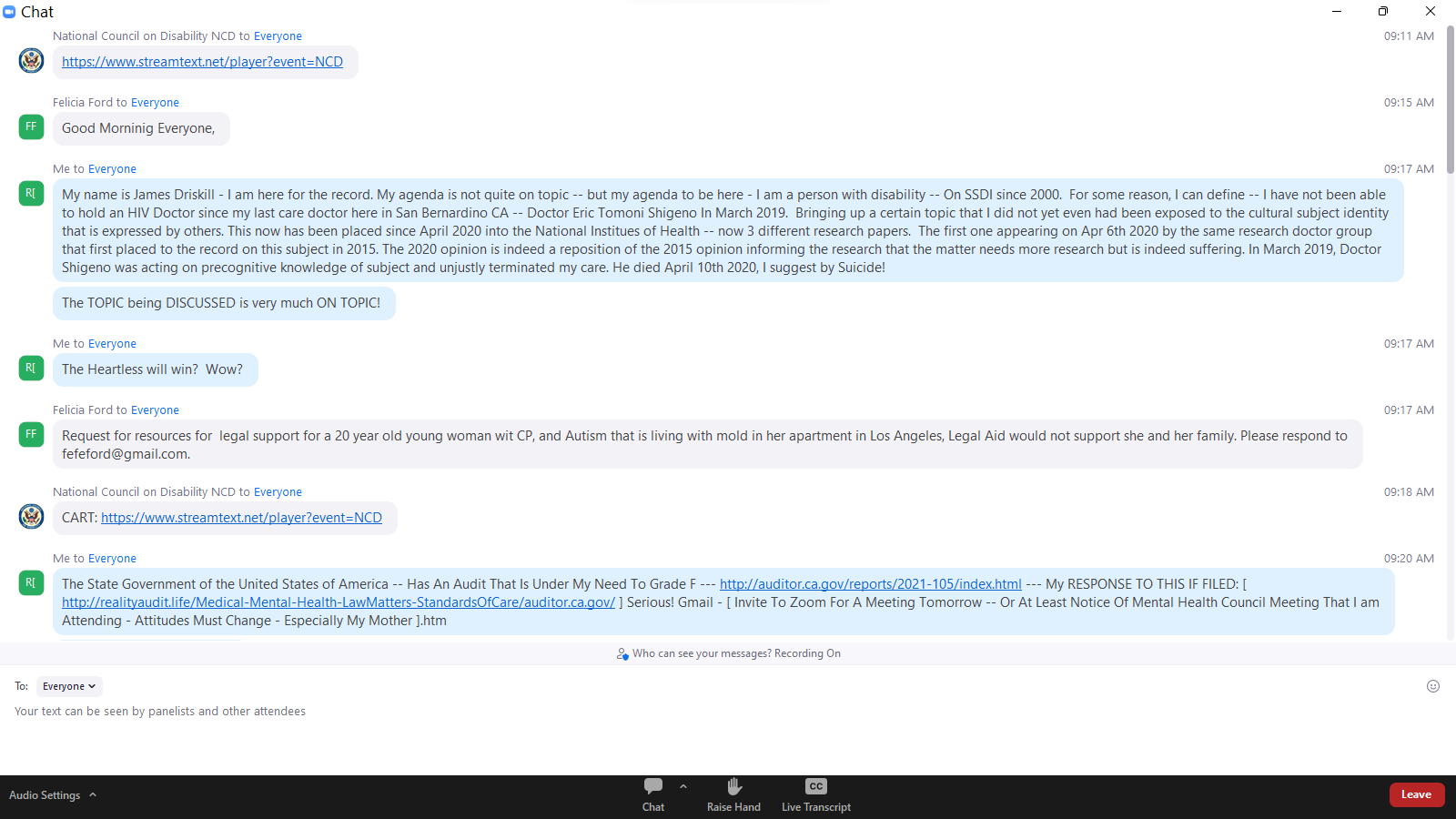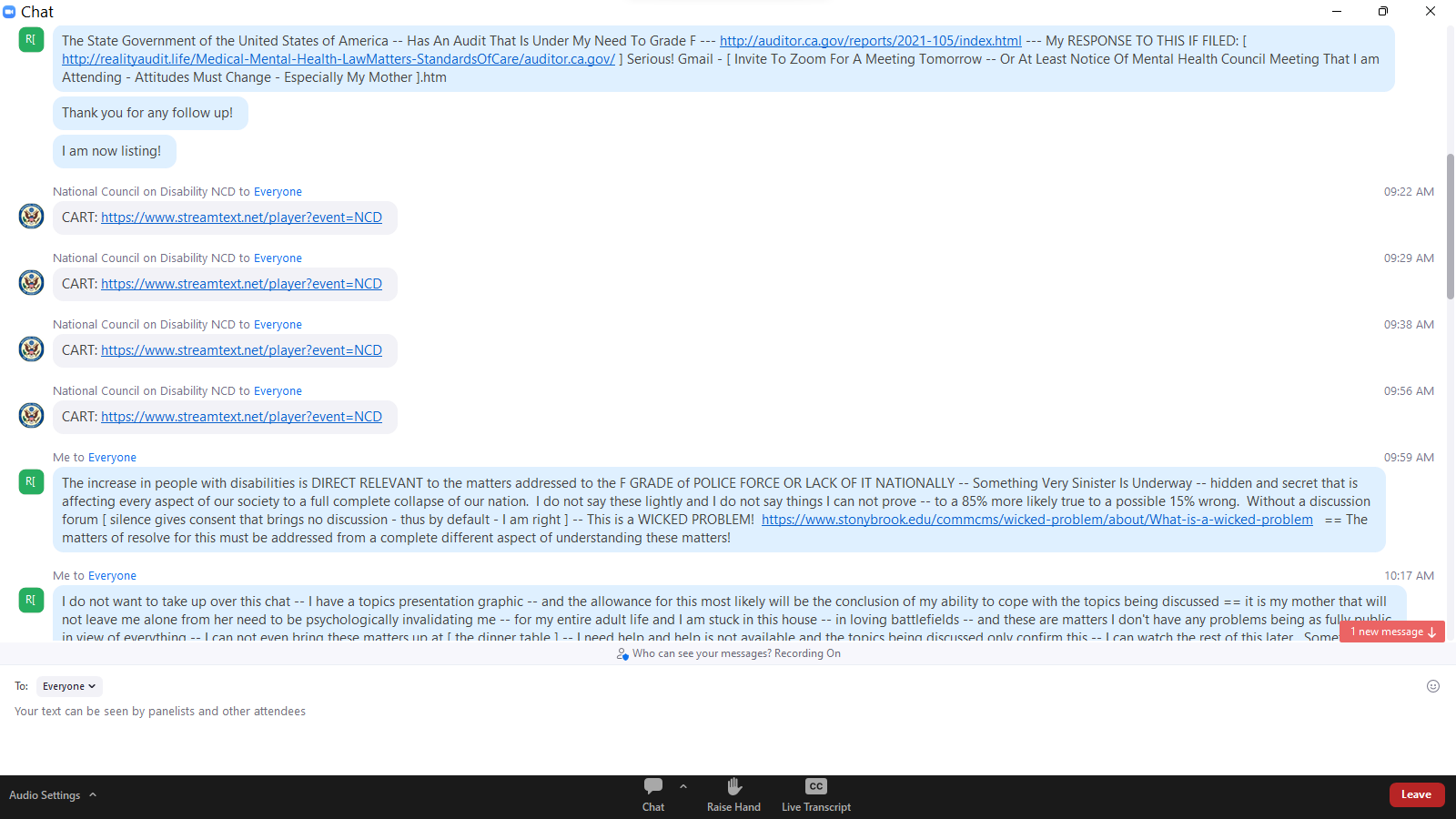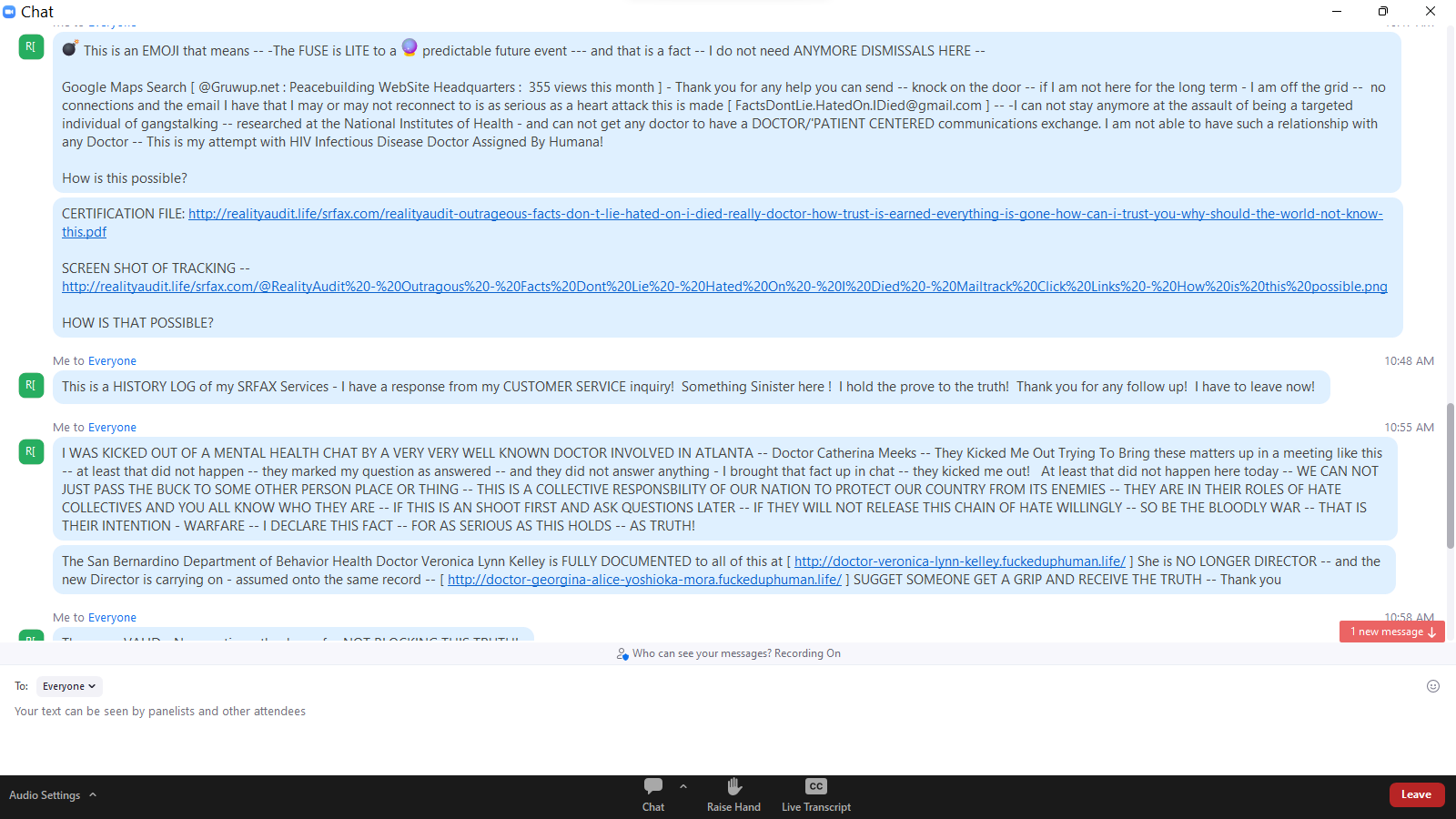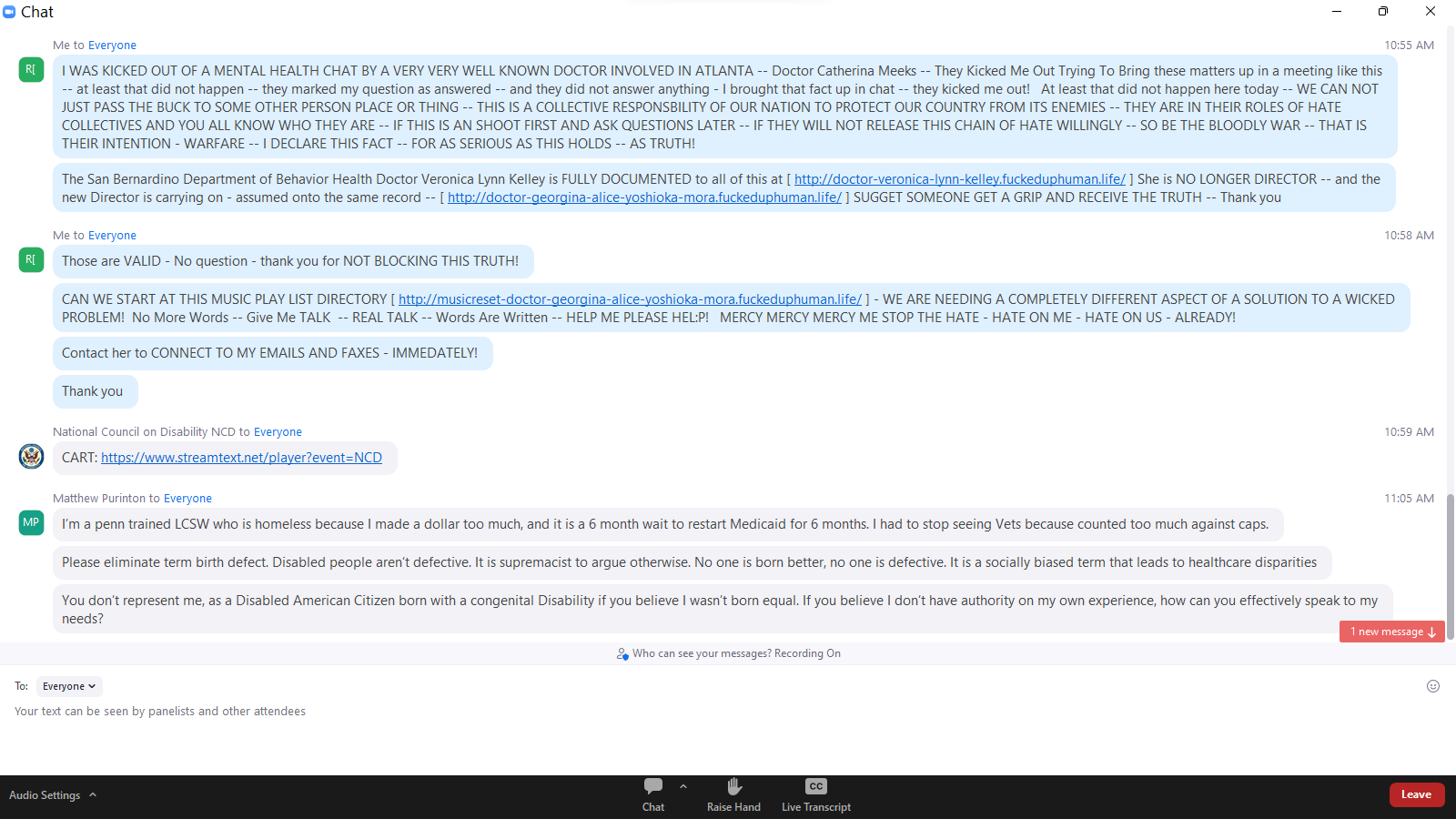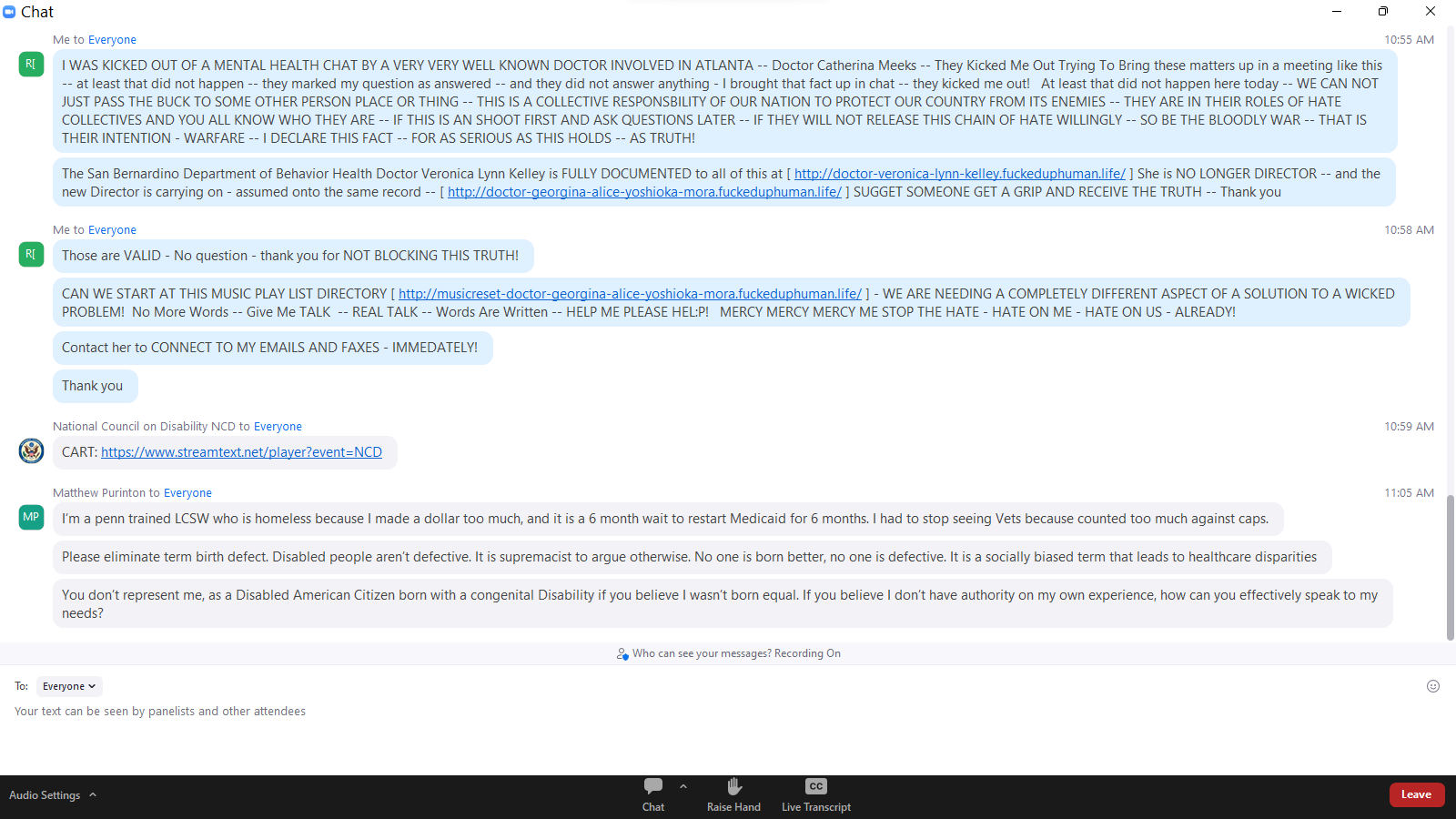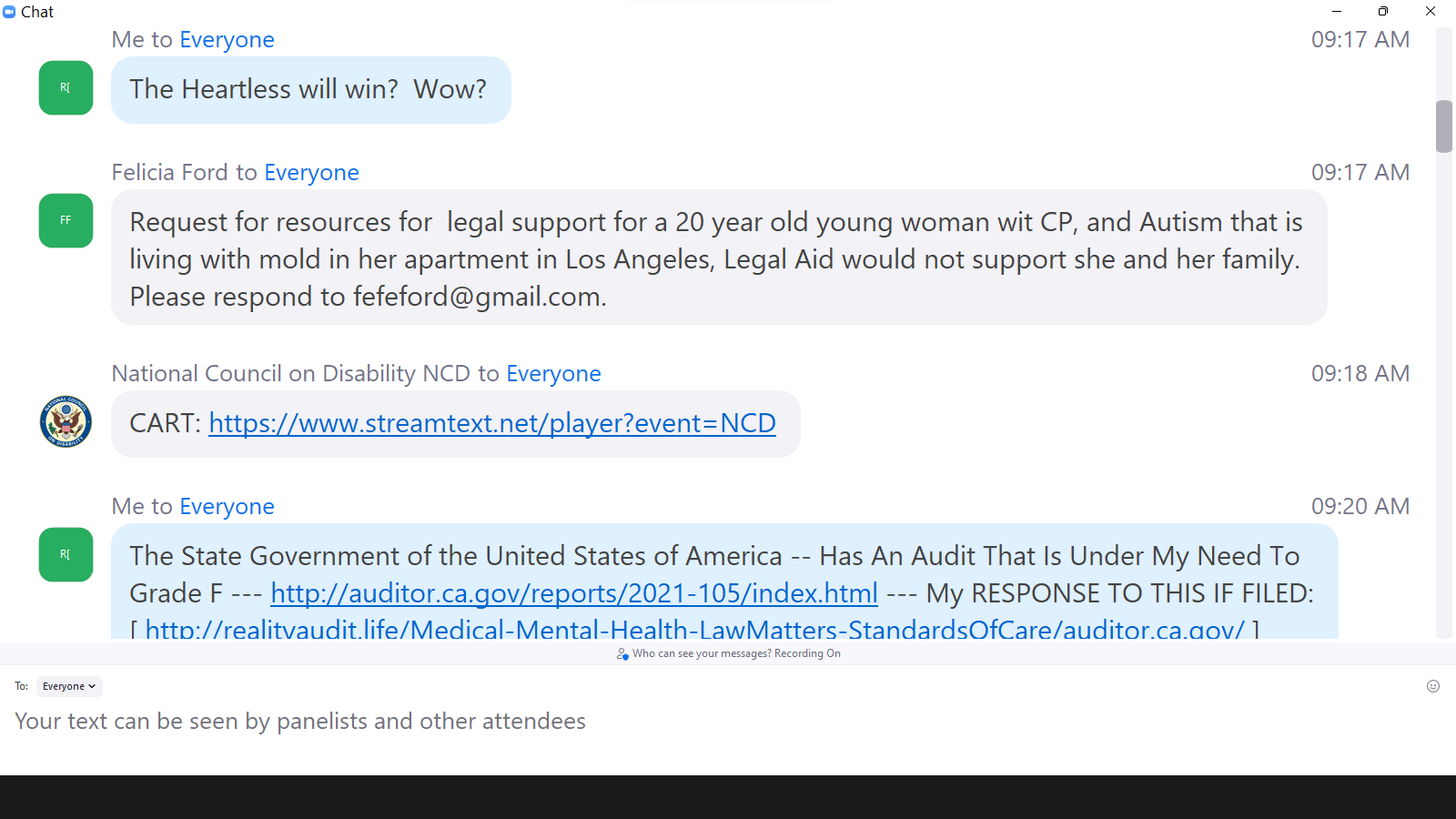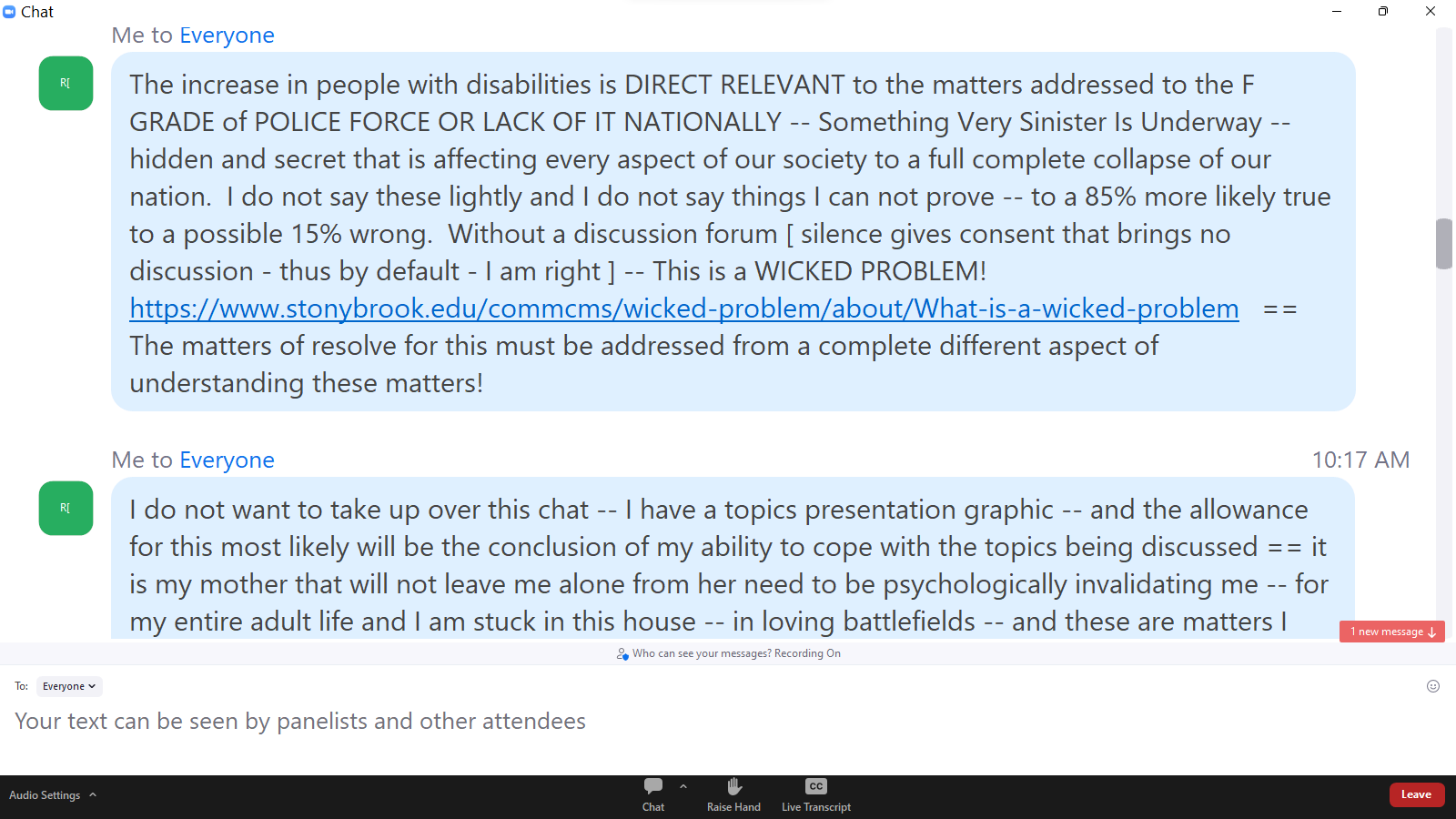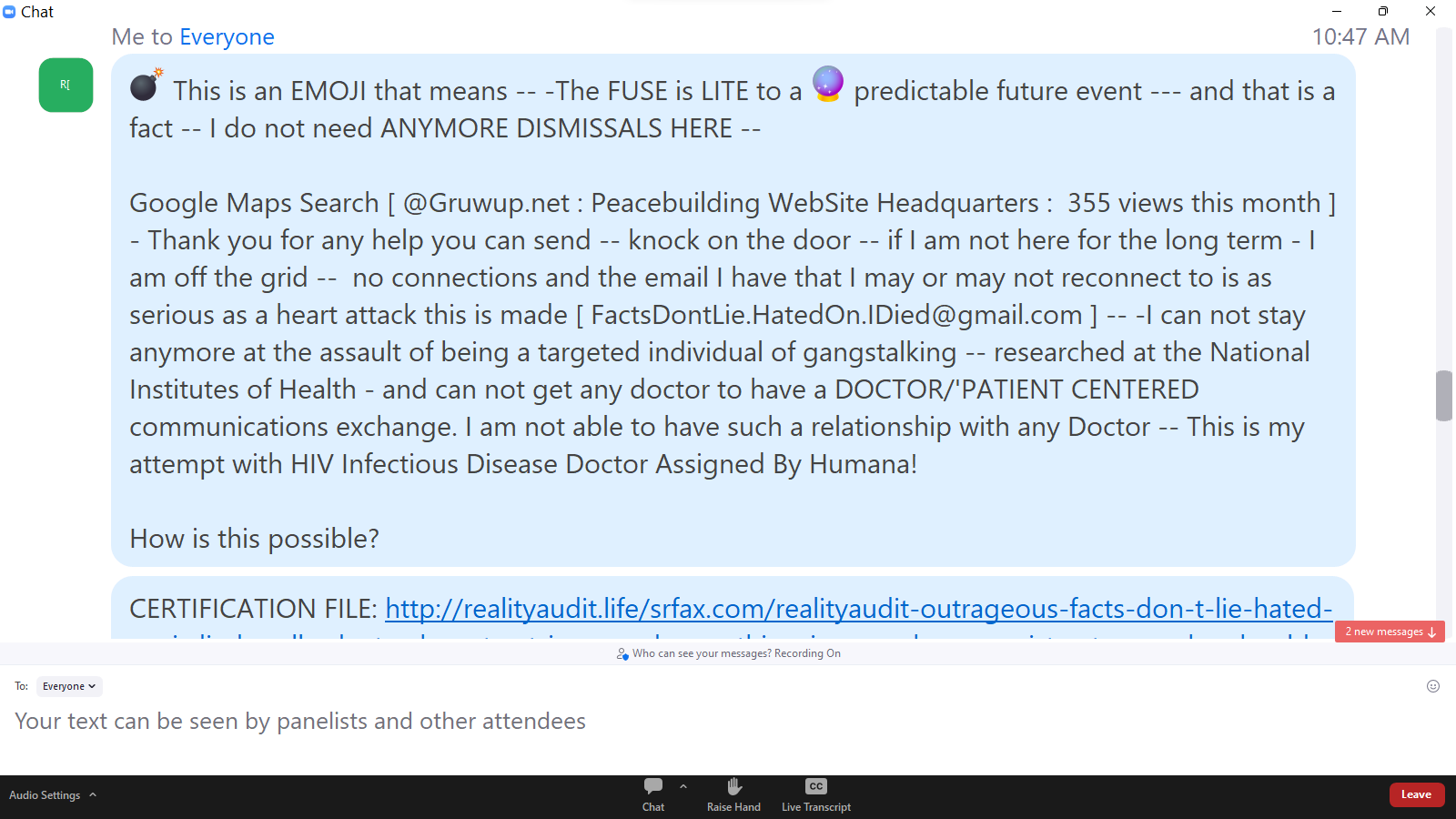THE FACT THAT YOU PROVIDED AN EMAIL ADDRESS IN CHAT
-- AND I CAN NOT JUST COPY AND PASTE IT INTO THIS VIEW - REFLECTS A
SINISTER CARRY-ON.
WHY KEEP THIS SO HARD TO DOCUMENT - THAT IS ABSOLUTELY A MARK OF INVOLVEMENT IN THIS TRUTH!
THE
THEME OF YOUR ENTIRE MEETING IS HOW RESOURCES ARE SO UNDERFUNDED -- AND
EXACTLY WHEN WAS THE CONVENTION FOR THE RIGHTS FOR PERSONS WITH
DISABILITIES FIRST SIGNED? 2009 -- WHAT THE FUCK IS WRONG HERE?
AN OBVIOUS BREACH OF ALL ASPECTS OF TRUST!
I AM COMPLETELY UNDERSTANDING WHAT IS UP!
AND
I DO NOT NEED TO BE REPRIMANDED FOR ATTEMPTING TO GET THE MORAL JUST
ACTION OUT OF A BUNCH OF FUCKED UP UP [ FOR A LONG TIME NOW ] FOOLS!
I
HOPE SOMEHOW -- THE CONDITIONS THAT ARE IN PLACE -- AND THE FACT THIS
GOES BACK GENERATIONS -- ACCORDING TO WHO IS HOLD MORAL RESPONSIBILITY
IN THIS
ONLY WHEN YOU ARE GIVEN THE HARM THAT
IS BEING DONE - DOES ONE CAPTURE THAT MORAL AGENCY -- SO - EVERYONE SITS
DOWN - AND TAKES A BIG GULP --
BUT SWALLOW THE BRICKS OF THE WALL - YOU DESERVE TO SHIT BRICKS!
THE
METAPHOR HERE - THE BRICK IS IN YOUR MOUTHS -- UNABLE TO SPEAK THE
TRUTH-- SWALLOW THE BRICK AND SHIT IT OUT THE OTHER END --
THE FIX FOR THIS IS AN ABSOLUTE -- DECONSTRUCTION -- IS AND ONLY IS DONE WITH A COMPLETE HONESTY OF THIS TRUTH!
I AM NOT THE ENEMY- DON'T ATTEMPT TO BLOCK THAT TRUTH -- TAKE YOUR NEED OF PAIN - BECAUSE THIS IS PAIN --
YOUR
ENTIRE THEME IS INFECTED TO WHY THIS IS HAPPENING -- THE TOPIC OF
ADDRESS IS ABSOLUTELY NEEDING A READDRESS OF A PARTICULAR NEED OF
FOCUS
- ON THE FOUNDATION OF THE PROBLEM! -- NOW - NOT NEXT SECOND -
NOW -- THIS SECOND OF TIME -NOT NEXT MINUTE - NOT NEXT HOUR - NOT NEXT
DAY
- NOT NEXT WEEK - NOT NEXT MONTH - NOT NExT YEAR - NOT NEXT DECADE [ if
we last that long ] -- THIS IMMEDIATE SECOND OF TIME.
THAT IS SECOND - A SECOND THAT IS 60 SECOND OF A MINUTe - THIS EXACT SECOND YOU READ THIS!
THIS
IS A RECORD OF THE LOG - I CAN OCR IT INTO A RECORD - THE TRANSCRIPT OF
THIS ENTIRE MEETING CAN BE THEN COMPARED TO MY WORK
ONLINE
-- A FLOW CHART OF ASSOCIATIONS -- NO QUESTION - I AM THE ONE WHO
CAN INDEED ASSOCIATE THE cAUSES OF THIS MASSIVE MISCHIEVOUS MARVEL OF
MOLDING MUCK
THE MATTER AT HAND - STOP THE LIES!
ACCEPT THE PAIN - NATIONALLY - THAT WE HAVE DONE THIS TO OURSELVES -- WE ARE UNDER AN ATTACK OF WARFARE -- PEOPLE!
THE SILENCE HOLDING -- THE COUNTRY IS NOT GOING TO SURVIVE!
IS THAT REALLY WHAT YOU WANT TO REPRESENT -- YOUR APATHY TOWARD THIS FACT?
[ "STOVE PIPE" ] In the Transcript of your Discussion Real-Time I write!
? Wow!
about 2,570,000 results (0.69 seconds) Stovepipe Wells is a way-station in the northern part of Death Valley, in unincorporated Inyo County, California. Stovepipe Wells. Unincorporated community.
------
There is HISTORY DRISKILL There! Seriously!
I CAN NOT TRUST YOU WILL LINK TO AN OUTSIDE RESOURCE - TO MAINTAIN YOUR NEED OF IGNORANCE - BY DEFAULT - YOUR MOTUS OPERENDI!
TIME FOR SOMETHING DIFFERENt - EDUCATE YOURSELF FOR A CHANGE
Computing and Moral ResponsibilityFirst published Wed Jul 18, 2012; substantive revision Fri Feb 16, 2018
Traditionally philosophical discussions on moral responsibility have
focused on the human components in moral action. Accounts of how to
ascribe moral responsibility usually describe human agents performing
actions that have well-defined, direct consequences. In today’s
increasingly technological society, however, human activity cannot be
properly understood without making reference to technological
artifacts, which complicates the ascription of moral responsibility
(Jonas 1984; Waelbers
2009).[1]
As we interact with and through these artifacts, they affect the
decisions that we make and how we make them (Latour 1992). They
persuade, facilitate and enable particular human cognitive processes,
actions or attitudes, while constraining, discouraging and inhibiting
others. For instance, internet search engines prioritize and present
information in a particular order, thereby influencing what internet
users get to see. As Verbeek points out, such technological artifacts
are “active mediators” that “actively co-shape
people’s being in the world: their perception and actions,
experience and existence” (2006, p. 364). As active mediators,
they change the character of human action and as a result it challenges
conventional notions of moral responsibility
(Jonas 1984; Johnson 2001).
Computing presents a particular case for understanding the role of
technology in moral responsibility. As these technologies become a
more integral part of daily activities, automate more decision-making
processes and continue to transform the way people communicate and
relate to each other, they further complicate the already problematic
tasks of attributing moral responsibility. The growing pervasiveness
of computer technologies in everyday life, the growing complexities of
these technologies and the new possibilities that they provide raise
new kinds of questions: who is responsible for the information
published on the Internet? Who is responsible when a self-driving
vehicle causes an accident? Who is accountable when electronic records
are lost or when they contain errors? To what extent and for what
period of time are developers of computer technologies accountable for
untoward consequences of their products? And as computer technologies
become more complex and behave increasingly autonomous can or should
humans still be held responsible for the behavior of these
technologies?
This entry will first look at the challenges that computing poses to
conventional notions of moral responsibility. The discussion will then
review two different ways in which various authors have addressed these
challenges: 1) by reconsidering the idea of moral agency and 2) by
rethinking the concept of moral responsibility itself.
Moral responsibility is about human action and its intentions and
consequences (Fisher 1999, Eshleman 2016). Generally speaking a
person or a group of people is morally responsible when their
voluntary actions have morally significant outcomes that would make it
appropriate to blame or praise them. Thus, we may consider it a
person’s moral responsibility to jump in the water and try to rescue
another person, when she sees that person drowning. If she manages to
pull the person from the water we are likely to praise her, whereas if
she refuses to help we may blame her. Ascribing moral responsibility
establishes a link between a person or a group of people and someone
or something that is affected by the actions of this person or
group. The person or group that performs the action and causes
something to happen is often referred to as the agent. The
person, group or thing that is affects by the action is referred to as
the patient. Establishing a link in terms of moral
responsibility between the agent and the patient can be done both
retrospectively as well as prospectively. That is, sometimes
ascriptions of responsibility involve giving an account of who was at
fault for an accident and who should be punished. It can also be about
prospectively determining the obligations and duties a person has to
fulfill in the future and what she ought to do.
However, the circumstances under which it is appropriate to ascribe moral
responsibility are not always clear. On the one hand the concept has varying
meanings and debates continue on what sets moral responsibility apart
from other kinds of responsibility (Hart 1968). The concept is
intertwined and sometimes overlaps with notions of accountability,
liability, blameworthiness, role-responsibility and causality. Opinions
also differ on which conditions warrant the attribution of moral
responsibility; whether it requires an agent with free will or not and
whether humans are the only entities to which moral responsibility can
be attributed (see the entry on
moral responsibility).
On the other hand, it can be difficult to establish a direct link
between the agent and the patient because of the complexity involved
in human activity, in particular in today’s technological society.
Individuals and institutions generally act with and in
sociotechnical systems in which tasks are distributed among
human and technological components, which mutually affect each other
in contingent ways (Bijker, Hughes and Pinch 1987). Increasingly
complex technologies can exacerbate the difficulty of identifying who
or what is ‘responsible’. When something goes wrong, a
retrospective account of what happened is expected and the more
complex the system, the more challenging is the task of ascribing
responsibility (Johnson and Powers 2005). Indeed, Matthias argues that
there is a growing ‘ responsibility gap’: the more complex
computer technologies become and the less human beings can directly
control or intervene in the behavior of these technologies, the less
we can reasonably hold human beings responsible for these technologies
(Matthias, 2004).
The increasing pervasiveness of computer technologies poses various
challenges to figuring out what moral responsibility entails and how
it should be properly ascribed. To explain how computing complicates
the ascription of responsibility we have to consider the conditions
under which it makes sense to hold someone responsible. Despite the
ongoing philosophical debates on the issue, most analysis of moral
responsibility share at least the following three conditions (Eshleman
2016; Jonas 1984):
-
There should be a causal connection between the person and the outcome
of actions. A person is usually only held responsible if she had some
control over the outcome of events.
-
The subject has to have knowledge of and be able to consider the
possible consequences of her actions. We tend to excuse someone from
blame if they could not have known that their actions would lead to a
harmful event.
-
The subject has to be able to freely choose to act in certain way. That
is, it does not make sense to hold someone responsible for a harmful
event if her actions were completely determined by outside forces.
A closer look at these three conditions shows that computing can
complicate the applicability of each of these conditions.
In order for a person to be held morally responsible for a
particular event, she has to be able to exert some kind of influence on
that event. It does not make sense to blame someone for an accident if
she could not have avoided it by acting differently or if she had no
control over the events leading up to the accident.
However, computer technologies can obscure the causal connections
between a person’s actions and the eventual consequences. Tracing the
sequence of events that led to a computer-related catastrophic
incident, such as a plane crash, usually leads in many directions, as
such incidents are seldom the result of a single error or
mishap. Technological accidents are commonly the product of an
accumulation of mistakes, misunderstanding or negligent behavior of
various individuals involved in the development, use and maintenance
of computer systems, including designers, engineers, technicians,
regulators, managers, users, manufacturers, sellers, resellers and
even policy makers.
The involvement of multiple actors in the development and
deployment of technologies gives rise to what is known as the problem
of ‘many hands’: it is difficult to determine who was
responsible for what when multiple individuals contributed to the
outcome of events (Friedman 1990; Nissenbaum 1994; Jonas 1984; van de
Poel et al. 2015). One classic example of the problem of many hands in
computing is the case of the malfunctioning radiation treatment
machine Therac-25 (Leveson and Turner 1993; Leveson 1995). This
computer-controlled machine was designed for the radiation treatment
of cancer patients as well as for X-rays. During a two-year period in
the 1980s the machine massively overdosed six patients, contributing
to the eventual death of three of them. These incidents were the
result of the combination of a number of factors, including software
errors, inadequate testing and quality assurance, exaggerated claims
about the reliability, bad interface design, overconfidence in
software design, and inadequate investigation or follow-up on accident
reports. Nevertheless, in their analysis of the events Leveson and
Turner conclude that it is hard to place the blame on a single
person. The actions or negligence of all those involved might not have
proven fatal were it not for the other contributing events. This is
not to say that there is no moral responsibility in this case
(Nissenbaum 1994; Gotterbarn 2001; Coeckelbergh 2012; Floridi 2013),
as many actors could have acted differently, but it makes it difficult
to retrospectively identify the appropriate person that can be called
upon to answer and make amends for the outcome.
Adding to the problem of many hands is the temporal and physical
distance that computing creates between a person and the consequences
of her actions, as this distance can blur the causal connection
between actions and events (Friedman 1990). Computational technologies
extend the reach of human activity through time and space. With the
help of social media and communication technologies people can
interact with others on the other side of the world. Satellites and
advanced communication technologies allow pilots to fly a
remote-controlled drone from their ground-control station half way
across the world. These technologies enable people to act over greater
distances, but this remoteness can dissociate the original actions
from its eventual consequences (Waelbers 2009; Coeckelbergh 2013). When
a person uses a technological artifact to perform an action thousands
of miles a way, that person might not know the people that will be
affected and she might not directly, or only partially, experience the
consequences. This can reduce the sense of responsibility the person
feels and it may interfere with her ability to fully comprehend the
significance of her actions. Similarly, the designers of an automated
decision-making system determine ahead of time how decisions should be
made, but they will rarely see how these decisions will impact the
individuals they affect. Their original actions in programming the
system may have effects on people years later.
The problem of many hands and the distancing effects of the use of
technology illustrate the mediating role of technological artifacts in
the confusion about moral responsibility. Technological artifacts
bring together the various different intentions of their creators and
users. People create and deploy technologies with the objective of
producing some effect in the world. Software developers develop an
Internet filter, often at the request of a manager or a client, with
the aim of shielding particular content from its users and influencing
what these users can or cannot read. The software has inscribed in its
design the various intentions of the developers, managers and clients;
it is poised to behave, given a particular input, according to their
ideas about which information is appropriate (Friedman 1997). Moral
responsibility can therefore not be attributed without looking at the
causal efficacy of these artifacts and how they constrain and enable
particular human activities. However, although technological artefacts
may influence and shape human action, they do not determine it.
They are not isolated instruments that mean and work the same
regardless of why, by whom, and in what context they are used; they
have interpretive flexibility (Bijker et al. 1987) or multistability (Ihde
1990).[2]
Although the design of the technology provides
a set of conditions for action, the form and meaning of these actions
is the result of how human agents choose to use these technologies in
particular contexts. People often use technologies in ways unforeseen
by their designers. This interpretive flexibility makes it difficult
for designers to anticipate all the possible outcomes of the use of
their technologies. The mediating role of computer technologies
complicates the effort of retrospectively tracing back the causal
connection between actions and outcomes, but it also complicates
forward-looking responsibility.
As computer technologies shape how people perceive and experience
the world, they affect the second condition for attributing moral
responsibility. In order to make appropriate decisions a person has to
be able to consider and deliberate about the consequences of her
actions. She has be aware of the possible risks or harms that her
actions might cause. It is unfair to hold someone responsible for
something if they could not have known that their actions might lead to
harm.
On the one hand computer technologies can help users to think
through what their actions or choices may lead to. They help the user
to capture, store, organize and analyze data and information (Zuboff
1982). For example, one often-named advantage of remote-controlled
robots used by the armed forces or rescue workers is that they enable
their operators to acquire information that would not be able
available without them. They allow their operators to look
“beyond the next hill” or “around the next
corner” and they can thus help operators to reflect on what the
consequences of particular tactical decisions might be (US Department
of Defense 2009). Similarly, data analysis tools can find patterns in
large volumes of data that human data analysts cannot manually process
(Boyd and Crawford 2012).
On the other hand the use of computers can constrain the ability of
users to understand or consider the outcomes of their actions. These
complex technologies, which are never fully free from errors,
increasingly hide the automated processes behind the interface (Van
den Hoven 2002). An example that illustrates how computer technologies
can limit understanding of the outcomes are the controversial risk
assessment tools used by judges in several states in the U.S. for
parole decisions and sentencing. In 2016 a civil society organization
found, based on an analysis of the risk scores of 7000 defendants
produced by one particular algorithm, that the scores poorly reflected
the actual recidivism rate and seemed to have a racial bias (Angwin et
al. 2016). Regardless of whether its findings were correct, what is
particularly relevant here is that the investigation also showed that
judges did not have a full understanding of how the probabilities were
calculated, because the algorithm was proprietary. The judges were
basing their sentencing on the suggestion of an algorithm that they
did not fully understand. This is the case for most computer
technologies today. Users only see part of the many computations that
a computer performs and are for the most part unaware of how it
performs them; they usually only have a partial understanding of the
assumptions, models and theories on which the information on their
computer screen is based.
The opacity of many computer systems can get in the way of
assessing the validity and relevance of the information and can
prevent a user from making appropriate decisions. People have a
tendency to either rely too much or not enough on the accuracy
automated systems (Cummings 2004; Parasuraman & Riley 1997). A
person’s ability to act responsibly, for example, can suffer when she
distrust the automation as result of a high rate of false alarms. In
the Therac 25 case, one of the machine’s operators testified that she
had become used to the many cryptic error messages the machine gave
and most did not involve patient safety (Leveson and Turner 1993,
p.24). She tended ignore them and therefore failed to notice when the
machine was set to overdose a patient. Too much reliance on automated
systems can have equally disastrous consequences. In 1988 the missile
cruiser U.S.S. Vincennes shot down an Iranian civilian jet airliner,
killing all 290 passengers onboard, after it mistakenly identified the
airliner as an attacking military aircraft (Gray 1997). The cruiser
was equipped with an Aegis defensive system that could automatically
track and target incoming missiles and enemy aircrafts. Analyses of
the events leading up to incident showed that overconfidence in the
abilities of the Aegis system prevented others from intervening when
they could have. Two other warships nearby had correctly identified
the aircraft as civilian. Yet, they did not dispute the Vincennes’
identification of the aircraft as a military aircraft. In a later
explanation Lt. Richard Thomas of one of the nearby ships stated,
“We called her Robocruiser… she always seemed to have a
picture… She always seemed to be telling everybody to get on or
off the link as though her picture was better” (as quoted in
Gray 1997, p. 34). The captains of both ships thought that the
sophisticated Aegis system provided the crew of Vincennes with
information they did not have.
Considering the possible consequences of one’s actions is further
complicated as computer technologies make it possible for humans to do
things that they could not do before. Several decades ago, the
philosopher Ladd pointed out, “[C]omputer technology has created
new modes of conduct and new social institutions, new vices and new
virtues, new ways of helping and new ways of abusing other
people” (Ladd 1989, p. 210–11). Computer technologies of
today have had a similar effect. The social or legal conventions that
govern what we can do with these technologies take some time to emerge
and the initial absence of these conventions contributes to confusion
about responsibilities (Taddeo and Floridi 2015). For example, the
ability for users to upload and share text, videos and images publicly
on the Internet raises a whole set of questions about who is
responsible for the content of the uploaded material. Such questions
were at the heart of the debate about the conviction of three Google
executives in Italy for a violation of the data protection act (Sartor
and Viola de Azevedo Cunha 2010). The case concerned a video on
YouTube of four students assaulting a disabled person. In response to
a request by the Italian Postal Police, Google, as owner of YouTube,
took the video down two months after the students uploaded it. The
judge, nonetheless, ruled that Google was criminally liable for
processing the video without taking adequate precautionary measures to
avoid privacy violations. The judge also held Google liable for
failing to adequately inform the students, who uploaded the videos, of
their data protection obligations (p. 367). In the ensuing debate
about the verdict, those critical of the ruling insisted that it
threatened the freedom of expression on the Internet and it sets a
dangerous precedent that can be used by authoritarian regimes to
justify web censorship (see also Singel 2010). Moreover, they claimed
that platform providers could not be held responsible for the actions
of their users, as they could not realistically approve every upload
and it was not their job to censure. Yet, others instead argued that
it would be immoral for Google to be exempt from liability for the
damage that others suffered due to Google’s profitable commercial
activity. Cases like this one show that in the confusion about the
possibilities and limitations of new technologies it can be difficult
to determine one’s moral obligations to others.
The lack of experience with new technological innovations can also
affect what counts as negligent use of the technology. In order to
operate a new computer system, users typically have to go through a
process of training and familiarization with the system. It requires
skill and experience to understand and imagine how the system will
behave (Coeckelbergh and Wackers 2007). Friedman describes the case of
a programmer who invented and was experimenting with a ‘computer
worm’, a piece of code that can replicate itself. At the time
this was a relatively new computational entity (1990). The programmer
released the worm on the Internet, but the experiment quickly got out
of the control when the code replicated much faster than he had
expected (see also Denning 1989). Today we would not find this a
satisfactory excuse, familiar as we have become with computer worms
and viruses. However, Friedman poses the question of whether the
programmer really acted in a negligent way if the consequences were
truly unanticipated. Does the computer community’s lack of experience
with a particular type of computational entity influence what we judge
to be negligent behavior?
The freedom to act is probably the most important condition for
attributing moral responsibility and also one of the most
contested. We tend to excuse people from moral blame if they had no
other choice but to act in the way that they did. We typically do not
hold people responsible if they were coerced or forced to take
particular actions. In moral philosophy, the freedom to act can also
mean that a person has free will or autonomy (Fisher 1999). Someone
can be held morally responsible because she acts on the basis of her
own authentic thoughts and motivations and has the capacity to control
her behavior (Johnson 2001). Note that this conception of autonomy is
differs from the way the term ‘autonomy’ is often used in
computer science, where it tends to refer to the ability of a robot or
computer system to independently perform complex tasks in
unpredictable environments for extended periods of time (Noorman
2009).
Nevertheless, there is little consensus on what capacities human
beings have, that other entities do not have, which enables them to act
freely (see the entries on
free will,
autonomy in moral and political philosophy,
personal autonomy
and
compatibilism).
Does it require rationality, emotion, intentionality or cognition?
Indeed, one important debate in moral philosophy centers on the
question of whether human beings really have autonomy or free will?
And, if not, can moral responsibility still be attributed (Eshleman
2016)?
In practice, attributing autonomy or free will to humans on the
basis of the fulfillment of a set of conditions turns out to be a less
than straightforward endeavor. We attribute autonomy to persons in
degrees. An adult is generally considered to be more autonomous than a child.
As individuals in a society our autonomy is thought to vary because
we are manipulated, controlled or influenced by forces outside of
ourselves, such as by our parents or through peer pressure. Moreover,
internal physical or psychological influences, such as addictions or
mental problems, are perceived as further constraining the autonomy of
a person.
Computing, like other technologies, adds an additional layer of
complexity to determining whether someone is free to act, as it affects
the choices that humans have and how they make them. One of the biggest
application areas of computing is the automation of decision-making
processes and control. Automation can help to centralize and increase
control over multiple processes for those in charge, while it limits
the discretionary power of human operators on the lower-end of the
decision-making chain. An example is provided by the automation of
decision-making in public administration (Bovens and Zouridis 2002).
Large public sector organizations have over the last few decades
progressively standardized and formalized their production processes.
The process of issuing decisions about student loans, speeding tickets
or tax returns is carried out almost entirely by computer systems. This
has reduced the scope of the administrative discretion that many
officials, such as tax inspectors, welfare workers, and policy
officers, have in deciding how to apply formal policy rules in
individual cases. Citizens no longer interact with officials that have
significant responsibility in applying their knowledge of the rules and
regulations to decide what is appropriate (e.g., would it be better to
let someone off with a warning or is a speeding ticket required?).
Rather, decisions are pre-programmed in the algorithms that apply the
same measures and rules regardless of the person or the context (e.g.,
a speeding camera does not care about the context). Responsibility for
decisions made, in these cases, has moved from ‘street-level
bureaucrats’ to the ‘system-level bureaucrats’, such
as managers and computer experts, that decide on how to convert policy
and legal frameworks into algorithms and decision-trees.
The automation of bureaucratic processes illustrates that some
computer technologies are intentionally designed to limit the
discretion of some human beings. Indeed the field of
Persuasive Technology explicitly aims to develop technological
artifacts that persuade humans to perform in ‘desirable’
ways (IJsselsteijn et al. 2006). An example is the anti-alcohol lock
that is already in use in a number of countries, including the USA,
Canada, Sweden and the UK. It requires the driver to pass a breathing
test before she can start the car. This technology forces a particular
kind of action and leaves the driver with hardly any choice. Other
technologies might have a more subtle way of steering behavior, by
either persuading or seducing users (Verbeek 2006). For example, the
onboard computer devices in some cars that show, in real-time,
information about fuel consumption can encourage the driver to optimize
fuel efficiency. Such technologies are designed with the explicit aim
of making humans behave responsibly by limiting their options or
persuading them to choose in a certain way.
Verbeek notes that critics of the idea of intentionally developing
technology to enforce morally desirable behavior have argued that it
jettisons the democratic principles of our society and threatens human
dignity. They argue that it deprives humans of their ability and rights
to make deliberate decisions and to act voluntarily. In addition,
critics have claimed that if humans are not acting freely, their
actions cannot be considered moral. These objections can be countered,
as Verbeek argues, by pointing to the rules, norms, regulations and a
host of technological artifacts that already set conditions for actions
that humans are able or allowed to perform. Moreover, he notes,
technological artifacts, as active mediators, affect the actions and
experiences of humans, but they do not determine them. Some people have
creatively circumvented the strict morality of the alcohol lock by
having an air pump in the car (Vidal 2004). Nevertheless, these
critiques underline the issues at stake in automating decision-making
processes: computing can set constraints on the freedom a person has to
act and thus affects the extent to which she can be held morally
responsible.
The challenges that computer technologies present with regard to the
conditions for ascribing responsibility indicate the limitations of
conventional ethical frameworks in dealing with the question of moral
responsibility. Traditional models of moral responsibility seem to be
developed for the kinds of actions performed by an individual that have
directly visible consequences (Waelbers 2009). However, in
today’s society attributions of responsibility to an individual
or a group of individuals are intertwined with the artifacts with which
they interact as well as with intentions and actions of other human
agents that these artifacts mediate. Acting with computer technologies
may require a different kind of analysis of who can be held responsible
and what it means to be morally responsible.
Moral responsibility is generally attributed to moral agents and, at
least in Western philosophical traditions, moral agency has been a
concept exclusively reserved for human beings (Johnson 2001; Doorn and
van de Poel 2012). Unlike animals or natural disasters, human beings
in these traditions can be the originators of morally significant
actions, as they can freely choose to act in one way rather than
another way and deliberate about the consequences of this choice. And,
although some people are inclined to anthropomorphize computers and
treat them as if they were moral agents (Reeves and Nass 1996; Nass
and Moon 2000; Rosenthal-von der Pütten 2013), most philosophers agree
that current computer technologies should not be called moral agents,
if that would mean that they could be held morally
responsible. However, the limitations of traditional ethical
vocabularies in thinking about the moral dimensions of computing have
led some authors to rethink the concept of moral agency.
The increasing complexity of computer technology and the advances in
Artificial Intelligence (AI), challenge the idea that human beings are
the only entities to which moral responsibility can or should be
ascribed (Bechtel 1985; Kroes and Verbeek 2014). Dennett, for example, suggests that holding a
computer morally responsible is possible if it concerned a higher-order
intentional computer system (1997). An intentional system, according to
him, is one that can be predicted and explained by attributing beliefs
and desires to it, as well as rationality. In other words, its behavior
can be described by assuming the systems has mental states and that it
acts according what it thinks it ought to do, given its beliefs and
desires. Many computers today, according to Dennett, are already
intentional systems, but they lack the higher-order ability to reflect
on and reason about their mental states. They do not have beliefs about
their beliefs or thoughts about desires. Dennett suggests that the
fictional HAL 9000 that featured in the movie 2001: A Space
Odyssey would qualify as a higher-order intentional system that
can be held morally responsible. Although current advances in AI might
not lead to HAL, he does see the development of computers systems with
higher-order intentionality as a real possibility.
Sullins argues in line with Dennett that moral agency is not
restricted to human beings (2006). He proposes that computers systems
or, more specifically, robots are moral agents when they have a
significant level of autonomy and they can be regarded at an
appropriate level of abstraction as exhibiting intentional behavior. A
robot, according to Sullins, would be significantly autonomous if it
was not under the direct control of other agents in performing its
tasks. Note that Sullins interprets autonomy in a narrow sense in
comparison to the conception of autonomy in moral philosophy as
property of human beings. He adds as a third condition that a robot
also has to be in a position of responsibility to be a moral
agent. That is, the robot performs some social role that carries with
it some responsibilities and in performing this role the robot appears
to have ‘beliefs’ about and an understanding of its duties
towards other moral agents (p. 28). To illustrate what kind of
capabilities are required for “full moral agency”, he
draws an analogy with a human nurse. He argues that if a robot was
autonomous enough to carry out the same duties as a human nurse and
had an understanding of its role and responsibilities in the health
care systems, then it would be a “full moral
agent”. Sullins maintains that it will be some time before
machines with these kinds of capabilities will be available, but
“even the modest robots of today can be seen to be moral agents
of a sort under certain, but not all, levels of abstraction and are
deserving of moral consideration” (p. 29).
Echoing objections to the early project of (strong) AI
(Sack 1997),[3]
critics of analyses such
as presented by Dennett and Sullins, have objected to the idea that
computer technologies can have capacities that make human beings moral
agents, such as mental states, intentionality, common sense or emotion
(Johnson 2006; Kuflik 1999). They, for instance, point out that it
makes no sense to treat computer system as moral agents that can be
held responsible, for they cannot suffer and thus cannot be punished
(Sparrow 2007; Asaro 2011). Or they argue, as Stahl does, that
computers are not capable of moral reasoning, because they do not have
the capacity to understand the meaning of the information that they
process (2006). In order to comprehend the meaning of moral statements
an agent has to be part of the form of life in which the statement is
meaningful; it has to be able to take part in moral discourses. Similar
to the debates about AI, critics continue to draw a distinction between
humans and computers by noting various capacities that computers do
not, and cannot, have that would justify the attribution of moral
agency.
In the absence of any definitive arguments for or against the
possibility of future computer systems being morally responsible,
researchers within the field of machine ethics aim to further develop
the discussion by focusing instead on creating computer system that can
behave as if they are moral agents (Moor 2006). Research
within this field has been concerned with the design and development of
computer systems that can independently determine what the right thing
to do would be in a given situation. According to Allen and Wallach,
such autonomous moral agents (AMAs) would have to be capable
of reasoning about the moral and social significance of their behavior
and use their assessment of the effects their behavior has on sentient
beings to make appropriate choices (2012; see also Wallach and Allen
2009 and Allen et al. 2000). Such abilities are needed, they argue,
because computers are becoming more and more complex and capable of
operating without direct human control in different contexts and
environments. Progressively autonomous technologies already in
development, such as military robots, driverless cars or trains and
service robots in the home and for healthcare, will be involved in
moral situations that directly affect the safety and well-being of
humans. An autonomous bomb disposal robot might in the future be faced
with the decision which bomb it should defuse first, in order to
minimize casualties. Similarly, a moral decision that a driverless car
might have to make is whether to break for a crossing dog or avoid the
risk of causing injury to the driver behind him. Such decisions require
judgment. Currently operators make such moral decisions, or the
decision is already inscribed in the design of the computer system.
Machine ethics, Wallach and Allen argue, goes one step beyond making
engineers aware of the values they build into the design of their
products, as it seeks to build ethical decision-making into the
machines.
To further specify what it means for computers to make ethical
decisions or to put ‘ethics in the machine’, Moor
distinguishes between three different kinds of ethical agents: implicit
ethical agents, explicit ethical agents, and full ethical agents
(2006). The first kind of agent is a computer that has the ethics of
its developers inscribed in their design. These agents are constructed
to adhere to the norms and values of the contexts in which they are
developed or will be used. Thus, ATM tellers are designed to have a
high level of security to prevent unauthorized people from drawing
money from accounts. An explicit ethical agent is a computer that can
‘do ethics’. In other words, it can on the basis of an
ethical model determine what would be the right thing to do, given
certain inputs. The ethical model can be based on traditional ethical
theories, such as Kantian or utilitarian ethics—depending on the
preferences of its creators. These agents would ‘make ethical
decisions’ on behalf of its human users (and developers). Such
agents are akin to the autonomous moral agents described by Allen and
Wallach. Finally, Moor defines full ethical agents as entities that can
make ethical judgments and can justify them, much like human beings
can. He claims that although there are no computer technologies today
that can be called fully ethical, it is an empirical question whether
or not it would be possible in the future.
The effort to build AMAs raises the question of how this effort
affects the ascription of moral responsibility. If these technologies
are not moral agents like human beings are, can they be held morally
responsible? As human beings would design these artificial agents to
behave within pre-specified formalized ethical frameworks, it is
likely that responsibility will still be ascribed to these human
actors and those that deploy these technologies. However, as Allen and
Wallach acknowledge, the danger of exclusively focusing on equipping
robots with moral decision-making abilities, rather than also looking
at the sociotechnical systems in which these robots are embedded, is
that it may cause further confusion about the distribution of
responsibility (2012). Robots with moral decision-making capabilities
may present similar challenges to ascribing responsibility as other
technologies, when they introduce new complexities that further
obfuscate causal connections that lead back to their creators and
users.
The prospect of increasingly autonomous and intelligent computer
technologies and the growing difficulty of finding responsible human
agents lead Floridi and Sanders to take a different approach (2004).
They propose to extend the class of moral agents to include artificial
agents, while disconnecting moral agency and moral accountability from
the notion of moral responsibility. They contend that “the
insurmountable difficulties for the traditional and now rather outdated
view that a human can be found accountable for certain kinds of
software and even hardware” demands a different approach (p.
372). Instead, they suggest that artificial agents should be
acknowledged as moral agents that can be held accountable, but not
responsible. To illustrate they draw a comparison between artificial
agents and dogs as sources of moral actions. Dogs can be the cause of a
morally charged action, like damaging property or helping to save a
person’s life, as in the case of search-and-rescue dogs. We can
identify them as moral agents even though we generally do not hold them
morally responsible, according to Floridi and Sanders: they are the
source of a moral action and can be held morally accountable by
correcting or punishing them.
Just like animals, Floridi and Sanders argue, artificial agents can
be seen as sources of moral actions and thus can be held morally
accountable when they can be conceived of as behaving like a moral
agent from an appropriate level of abstraction. The notion of
levels of abstraction refers to the stance one adopts towards and
entity to predict and explain its behavior. At a low level of
abstraction we would explain the behavior of a system in terms of its
mechanical or biological processes. At a higher level of abstraction it
can help to describe the behavior of a system in terms of beliefs,
desires and thoughts. If at a high enough level a computational system
can effectively be described as being interactive, autonomous and
adaptive, then it can be held accountable according to Floridi and
Sanders (p. 352). It, thus, does not require personhood or free will
for an agent to be morally accountable; rather the agent has to act as
if it had intentions and was able to make choices.
The advantage of disconnecting accountability from responsibility,
according to Floridi and Sanders, is that it places the focus on moral
agenthood, accountability and censure, instead of on figuring out which
human agents are responsible. “We are less likely to assign
responsibility at any cost, forced by the necessity to identify a human
moral agent. We can liberate technological development of AAs
[Artificial Agents] from being bound by the standard limiting
view” (p. 376). When artificial agents ‘behave badly’
they can be dealt with directly, when their autonomous behavior and
complexity makes it too difficult to distribute responsibility among
human agents. Immoral agents can be modified or deleted. It is then
possible to attribute moral accountability even when moral
responsibility cannot be determined.
Critics of Floridi’s and Sanders’ view on accountability and moral
agency argue that placing the focus of analysis on computational
artifacts by treating them as moral agents will draw attention away
from the humans that deploy and develop them. Johnson, for instance,
makes the case that computer technologies remain connected to the
intentionality of their creators and users (2006). She argues that
although computational artifacts are a part of the moral world and
should be recognized as entities that have moral relevance, they are
not moral agents, for they are not intentional. They are not
intentional, because they do not have mental states or a purpose that
comes from the freedom to act. She emphasizes that although these
artifacts are not intentional, they do have intentionality, but their
intentionality is related to their functionality. They are human-made
artifacts and their design and use reflect the intentions of designers
and users. Human users, in turn, use their intentionality to interact
with and through the software. In interacting with the artifacts they
activate the inscribed intentions of the designers and developers. It
is through human activity that computer technology is designed,
developed, tested, installed, initiated and provided with input and
instructions to perform specified tasks. Without this human activity,
computers would do nothing. Attributing independent moral agency to
computers, Johnson claims, disconnects them from the human behavior
that creates, deploys and uses them. It turns the attention away from
the forces that shape technological development and limits the
possibility for intervention. For instance, it leaves the issue of
sorting out who is responsible for dealing with malfunctioning or
immoral artificial agents or who should make amends for the harmful
events they may cause. It postpones the question of who has to account
for the conditions under which artificial agents are allowed to
operate (Noorman 2009).
Yet, to say that technologies are not moral agents is not to say
that they are not part of moral action. Several philosophers have
stressed that moral responsibility cannot be properly understood
without recognizing the active role of technology in shaping human
action (Jonas 1984; Verbeek 2006; Johnson and Powers 2005; Waelbers
2009). Johnson, for instance, claims that although computers are not
moral agents, the artifact designer, the artifact, and the artifact
user should all be the focus of moral evaluation as they are all at
work in an action (Johnson 2006). Humans create these
artifacts and inscribe in them their particular values and intentions
to achieve particular effects in the world and in turn these
technological artifacts influence what human beings can and cannot do
and affect how they perceive and interpret the world.
Similarly, Verbeek maintains that technological artifacts alone do
not have moral agency, but moral agency is hardly ever
‘purely’ human. Moral agency generally involves a
mediating artifact that shapes human behavior, often in way not
anticipated by the designer (2008). Moral decisions and actions are
co-shaped by technological artifacts. He suggests that in all forms of
human action there are three forms of agency at work: 1) the agency of
the human performing the action; 2) the agency of the designer who
helped shaped the mediating role of the artifacts and 3) the artifact
mediating human action. The agency of artifacts is inextricably linked
to the agency of its designers and users, but it cannot be reduced to
either of them. For him, then, a subject that acts or makes moral
decisions is a composite of human and technological components. Moral
agency is not merely located in a human being, but in a complex blend
of humans and technologies.
In later papers, Floridi explores the concept of distributed moral
actions (2013, 2016). He argues that some moral significant outcomes
cannot be reduced to the moral significant actions of some
individuals. Morally neutral actions of several individuals can still
result in morally significant events. Individuals might not have
intended to cause harm, but nevertheless their combined actions may
still result in moral harm to someone or something. In order to deal
with the problem of subsequently assigning moral responsibility for
such distributed moral actions, he argues that the focus of analysis
should shift from the agents to the patients of moral actions. A moral
action can then be evaluated in terms of the harm to the patient,
regardless of the intentions of the agents involved. Assigning
responsibility then focuses on whether or not an agent is causally
accountable for the outcome and on adjusting their behavior to prevent
harm. If the agents causally accountable - be they artificial or
biological - are autonomous, can interact with each other and their
environments and can learn from their interactions they can be held
responsible for distributed moral actions, according to Floridi
(2016).
In light of the noted difficulties in ascribing moral
responsibility, several authors have critiqued the way in which the
concept is used and interpreted in relation to computing. They claim
that the traditional models or frameworks for dealing with moral
responsibility fall short and propose different perspectives or
interpretations to address some of the difficulties.
One approach is to rethink how moral responsibility is assigned
(Gotterbarn 2001; Waelbers 2009). When it comes to computing
practitioners, Gotterbarn identifies a potential to side-step or avoid
responsibility by looking for someone else to blame. He attributes this
potential to two pervasive misconceptions about responsibility. The
first misconception is that computing is an ethically neutral practice.
According to Gotterbarn this misplaced belief that technological
artifacts and the practices of building them are ethically neutral is
often used to justify a narrow technology-centered focus on the
development of computer system without taking the broader context in
which these technologies operate into account. This narrow focus can
have detrimental consequences. Gotterbarn gives the example of a
programmer who was given the assignment to write a program that could
lower or raise an X-ray device on a pole, after an X-ray technician set
the required height. The programmer focused on solving the given
puzzle, but failed to take account of the circumstances in which the
device would be used and the contingencies that might occur. He, thus,
did not consider the possibility that a patient could accidentally be in
the way of the device moving up and down the pole. This oversight
eventually resulted in a tragic accident. A patient was crushed by the device, when a
technician set the device to tabletop height, not realizing that the
patient was still underneath it. According to Gotterbarn, computer
practitioners have a moral responsibility to consider such
contingencies, even though they may not be legally required to do so.
The design and use of technological artifacts is a moral activity and
the choice for one particular design solution over another has real and
material consequences.
The second misconception is that responsibility is only about
determining blame when something goes wrong. Computer practitioners,
according to Gotterbarn, have conventionally adopted a malpractice
model of responsibility that focuses on determining the appropriate
person to blame for harmful incidents (2001). This malpractice model leads to
all sorts of excuses to shirk responsibility. In particular, the
complexities that computer technologies introduce allow computer
practitioners to side-step responsibility. The distance between
developers and the effects of the use of the technologies they create
can, for instance, be used to claim that there is no direct and
immediate causal link that would tie developers to a malfunction.
Developers can argue that their contribution to the chain of events was
negligible, as they are part of a team or larger organization and they
had limited opportunity to do otherwise. The malpractice model,
according to Gotterbarn, entices computer practitioners to distance
themselves from accountability and blame.
The two misconceptions are based on a particular view of
responsibility that places the focus on that which exempts one from
blame and liability. In reference to Ladd, Gotterbarn calls this
negative responsibility and distinguishes it from positive
responsibility (see also Ladd 1989). Positive responsibility
emphasizes “the virtue of having or being obliged to have regard
for the consequences that his or her actions have on others”
(Gotterbarn 2001, p. 227). Positive responsibility entails that part
of the professionalism of computer experts is that they strive to
minimize foreseeable undesirable events. It focuses on what ought to be
done rather than on blaming or punishing others for irresponsible
behavior. Gotterbarn argues that the computing professions should adopt
a positive concept of responsibility, as it emphasizes the obligations
and duties of computer practitioners to have regard for the
consequences of one’s actions and to minimize the possibility of
causing harm. Computer practitioners have a moral responsibility to
avoid harm and to deliver a properly working product, according to him,
regardless of whether they will be held accountable if things turn out
differently.
The emphasis on the prospective moral responsibility of computer
practitioners raises the question of how far this responsibility
reaches, in particular in light of systems that many hands help create
and the difficulties involved in anticipating contingencies that might
cause a system to malfunction (Stieb 2008; Miller 2008). To what
extent can developers and manufacturers be expected to exert themselves
to anticipate or prevent the consequences of the use of their
technologies or possible ‘bugs’ in their code? These
systems are generally incomprehensible to any single programmer and it
seems unlikely that complex computer systems can be completely error
free. Moreover, designers and engineers cannot foresee all the possible
conditions under which their products will eventually operate. Should
manufacturers of mobile phones have anticipated that their products
would be used in roadside bombs? A more fundamental question is whether
computer programmers have a broader responsibility to the welfare of
the public or just to their employer?
Nevertheless, the distinction between positive and negative
responsibility underlines that holding someone morally responsible has
a social function, which provides yet another perspective on the issue
(Stahl 2006; Eshleman 2016). Both prospectively and retrospectively,
responsibility works to organize social relations between people and
between people and institutions. It sets expectations between people
for the fulfillment of certain obligations and duties and provides the
means to correct or encourage certain behavior. For instance, a
robotics company is expected to build in safeguards that prevent
robots from harming humans. If the company fails to live up to this
expectation, it will be held accountable and in some cases it will
have to pay for damages or undergo some other kind of punishment. The
punishment or prospect of punishment can encourage the company to have
more regard for system safety, reliability, sound design and the risks
involved in their production of robots. It might trigger the company
to take actions to prevent future accidents. Yet, it might also
encourage it to find ways to shift the blame. The idea that
responsibility is about interpersonal relationships and expectations
about duties and obligations places the focus on the practices of
holding someone responsible (Eshleman 2016).
The particular practices and social structures that are in place to
ascribe responsibility and hold people accountable, have an influence
on how we relate to technologies. Nissenbaum contends that the
difficulties in attributing moral responsibility can, to a large
extent, be traced back to the particular characteristics of the
organizational and cultural context in which computer technologies are
embedded. She argues that how we conceive of the nature, capacities and
limitations of computing is of influence on the answerability of those
who develop and use computer technologies (1997). She observes a
systematic erosion of accountability in our increasingly computerized
society, where she conceives of accountability as a value and a
practice that places an emphasis on preventing harm and risk.
Accountability means there will be someone, or several people,
to answer not only for the malfunctions in life-critical systems that
cause or risk grave injuries and cause infrastructure and large
monetary losses, but even for the malfunction that cause individual
losses of time, convenience, and contentment. (1994, p. 74)
It can be used as “a powerful tool for motivating better
practices, and consequently more reliable and trustworthy
systems” (1997, p. 43). Holding people accountable for the
harms or risks caused by computer systems provides a strong incentive
to minimize them and can provide a starting point for assigning just
punishment.
Cultural and organizational practices however do the opposite, due
to “the conditions under which computer technologies are
commonly developed and deployed, coupled with popular conceptions
about the nature, capacities and limitations of computing”
(p. 43). Nissenbaum identifies four barriers to accountability in
today’s society: (1) the problem of many hands, (2) the acceptance of
computer bugs as an inherent element of large software systems, (3)
using the computer as scapegoat and (4) ownership without
liability. According to Nissenbaum people have a tendency to shirk
responsibility and to shift the blame to others when accidents
occur. The problem of many hands and the idea that software bugs are
an inevitable by-product of complex computer systems are too easily
accepted as excuses for not answering for harmful outcomes. People are
also inclined to point the finger at the complexity of the computer
and argue that “it was the computer’s fault” when things
go wrong. Finally, she perceives a tendency of companies to claim
ownership of the software they develop, but to dismiss the
responsibilities that come with ownership. Current day computer
programs come with extended license agreements that assert the
manufacturer’s ownership of the software, but disclaim any
accountability for the quality or performance of the product. They
also dismiss any liability for the consequential damages resulting
from defects in the software.
These four barriers, Nissenbaum holds, stand in the way of a
“culture of accountability” that is aimed at maintaining
clear lines of accountability. Such a culture fosters a strong sense
of responsibility as a virtue to be encouraged and everyone connected
to an outcome of particular actions is answerable for it.
Accountability, according to Nissenbaum, is different from liability.
Liability is about looking for a person to blame and to compensate for
damages suffered after the event. Once that person has been found,
others can be let ‘off the hook’, which may encourage
people to look for excuses, such as blaming the
computer. Accountability, however, applies to all those involved. It
requires a particular kind of organizational context, one in which
answerability works to entice people to pay greater attention to
system safety, reliability and sound design, in order to establish a
culture of accountability. An organization that places less value on
accountability and that has little regards for responsibilities in
organizing their production processes is more likely to allow their
technological products to become incomprehensible. Nissenbaum’s
analysis illustrates that our practices of holding someone responsible
- the established ways of holding people to account and of conveying
expectations about duties and obligations - are continuously changing
and negotiated, partly as a response to the introduction of new
technologies (see also Noorman 2012).
Nissenbaum argues that the context in which technologies are developed
and used has a significant influence on the ascription of moral
responsibility, but several authors have stressed that moral
responsibility cannot be properly understood without recognizing the
active role of technology in shaping human action (Jonas 1984; Verbeek
2006; Johnson and Powers 2005; Waelbers 2009). According to Johnson
and Powers it is not enough to just look at what humans intend and
do. “Ascribing more responsibility to persons who act with
technology requires coming to grips with the behavior of the
technology” (p. 107). One has to consider the various ways in
which technological artifacts mediate human actions. Moral
responsibility is, thus, not only about how the actions of a person or
a group of people affect others in a morally significant way; it is
also about how their actions are shaped by technology. Moral
responsibility from this perspective is not located in an individual
or an interpersonal relationship, but is distributed among humans and
technologies.
Computer technologies have challenged conventional conceptions of
moral responsibility and have raised questions about how to
distributed responsibility appropriately. Can human beings still be
held responsible for the behavior of complex computer technologies
that they have limited control over or understanding of? Are human
beings the only agents that can be held morally responsible or can the
concept of moral agent be extended to include artificial computational
entities? In response to such questions philosophers have reexamined
the concepts of moral agency and moral responsibility. Although there
is no clear consensus on what these concepts should entail in an
increasingly digital society, what is clear from the discussions is
that any reflection on these concepts will need to address how these
technologies affect human action and the boundaries between computer
technologies and human beings.
- Allen, C. & W. Wallach, 2012. “Moral Machines. Contradiction in
Terms or Abdication of Human Responsibility?” in P. Lin, K. Abney, and
G. Bekey (eds.), Robot ethics. The ethics and social implications
of robotics. Cambridge, Massachusetts: MIT Press.
- Allen, C., G. Varner & J. Zinser, 2000. “Prolegomena to
any Future Artificial Moral Agent,” Journal of Experimental and
Theoretical Artificial Intelligence, 12: 251–261.
- Allen, C. W. Wallach & I. Smit, 2006. “Why Machine Ethics?”
Intelligent Systems, IEEE , 21(4): 12–17.
- Angwin, J., J. Larson, S. Mattu & L. Kirchner,
2016. “Machine Bias. There is software that is used across the
county to predict future criminals. And it is biased against
blacks”, ProPublica, May 23, 2016,
available online.
- Asaro, P., 2011. “A Body to Kick, But Still No Soul to Damn: Legal
Perspectives on Robotics,” in P. Lin, K. Abney, and G. Bekey (eds.)
Robot Ethics: The Ethical and Social Implications of Robotics,
Cambridge, MA: MIT Press.
- Bechtel, W., 1985. “Attributing Responsibility to Computer Systems,”
Metaphilosophy, 16(4): 296–306.
- Bijker, W. E., T. P. Hughes, & T. Pinch, 1987. The
Social Construction of Technological Systems: New Directions in the
Sociology and History of Technology, London, UK: The MIT
Press.
- Bovens, M. & S. Zouridis, 2002. “From street-level to
system-level bureaucracies: how information and communication
technology is transforming administrative discretion and constitutional
control,” Public Administration Review, 62(2):174–184.
- Boyd, D. & K. Crawford, 2012. “Critical Questions for
Big Data: Provocations for a Cultural, Technological, and Scholarly
Phenomenon,” Information, Communication, & Society
15(5): 662–679.
- Coeckelbergh, M. & R. Wackers, 2007. “Imagination,
Distributed Responsibility and Vulnerable Technological Systems: the
Case of Snorre A,” Science and Engineering Ethics, 13(2): 235–248.
- Cummings, M. L., 2004. “Automation Bias in Intelligent Time
Critical Decision Support Systems,” Paper presented at the AIAA 1st
Intelligent Systems Technical Conference, Chicago.
- Dennett, D. C., 1997. “When HAL Kills, Who’s to Blame? Computer
Ethics,” in HAL’s Legacy: 2001’s Computer as Dream and Reality,
D. G. Stork (ed.), Cambridge, MA: MIT Press.
- Denning, P. J., 1989. “The Science of Computing: The Internet Worm,”
American Scientist, 77(2): 126–128.
- Doorn, N. & van de Poel, I., 2012. “Editors Overview:
Moral Responsibility in Technology and Engineering,” Science
and Engineering Ethics, 18: 1–11.
- Eshleman, A., 2016. “Moral Responsibility,” in
The Stanford Encyclopedia of Philosophy (Winter 2016 Edition),
E. N. Zalta (ed.), URL =
<https://plato.stanford.edu/archives/win2016/entries/moral-responsibility/>.
- Fisher, J. M., 1999. “Recent work on moral responsibility,”
Ethics, 110(1): 93–139.
- Floridi, L., & J. Sanders, 2004. “On the Morality of
Artificial Agents,” Minds and Machines, 14(3): 349–379.
- Floridi, L., 2013. “Distributed morality in an information
society,” Science and Engineering Ethics, 19(3):
727–743.
- –––, 2016. “Faultless responsibility: on
the nature and allocation of moral responsibility for distributed
moral actions,” Philosophical Transactions of the Royal
Society A (Mathematical Physical and Engineering
Sciences), 374(2083); doi: 10.1098/rsta.2016.0112
- Friedman, B., 1990. “Moral Responsibility and Computer Technology,”
Paper Presented at the Annual Meeting of the American Educational
Research Association, Boston, Massachusetts.
- ––– (ed.), 1997. Human Values and the Design
of Computer Technology, Stanford: CSLI Publications; New York:
Cambridge University Press
- Gotterbarn D., 2001. “Informatics and professional responsibility,”
Science and Engineering Ethics, 7(2): 221–230.
- Graubard, S. R., 1988. The Artificial Intelligence Debate:
False Starts, Real Foundations, Cambridge Massachusetts: The MIT
Press.
- Gray, C. H., 1997. “AI at War: The Aegis System in
Combat,” Directions and Implications of Advanced
Computing, D. Schuler, (ed.), New York: Ablex,
pp. 62–79.
- Hart, H. L. A., 1968. Punishment and Responsibility,
Oxford: Oxford University Press.
- Hughes, T.P., 1987. “The evolution of Large Technological
System,” in W. E. Bijker, T. P. Hughes, & T. Pinch (eds.),
The Social Construction of Technological Systems, Cambridge,
MA: The MIT Press, pp. 51–82.
- IJsselsteijn, W., Y. de Korte, C. Midden, B. Eggen, & E.
Hoven (eds.), 2006. Persuasive Technology, Berlin:
Springer-Verlag.
- Johnson, D. G., 2001. Computer Ethics, 3rd edition, Upper Saddle River,
New Jersey: Prentice Hall.
- –––, 2006. “Computer Systems: Moral
Entities but not Moral Agents,” Ethics and Information
Technology, 8: 195–204.
- Johnson, D. G. & T. M. Power, 2005. “Computer systems and
responsibility: A normative look at technological complexity,”
Ethics and Information Technology, 7: 99–107.
- Jonas, H., 1984. The Imperative of Responsibility. In search
of an Ethics for the Technological Age, Chicago: The Chicago
University Press.
- Kroes, P.& P.P. Verbeek (eds.), 2014. The Moral Status of
Technical Artefacts, Dordrecht: Springer
- Kuflik, A., 1999. “Computers in Control: Rational Transfer of
Authority or Irresponsible Abdication of Authority?” Ethics and
Information Technology, 1: 173–184.
- Ladd. J., 1989. “Computers and Moral Responsibility. A Framework
for an Ethical Analysis,” in C.C. Gould (ed.), The Information Web.
Ethical and Social Implications of Computer Networking, Boulder,
Colorado: Westview Press, pp. 207–228.
- Latour, B., 1992. “Where are the Missing Masses? The Sociology of a
Few Mundane Artefacts,” in W. Bijker & J. Law (eds.),
Shaping Technology/Building Society: Studies in Socio-Technical
Change, Cambridge, Massachusetts: The MIT press, pp. 225–258.
- Leveson, N. G. & C. S. Turner, 1993. “An Investigation of the
Therac-25 Accidents,” Computer, 26(7): 18–41.
- Leveson, N., 1995. “Medical Devices: The Therac-25,” in N.
Leveson, Safeware. System, Safety and Computers,
Boston: Addison-Wesley.
- Matthias, A., 2004. “The responsibility gap: Ascribing
responsibility for the actions of learning automata,” Ethics
and Information Technology, 6: 175–183.
- McCorduck, P., 1979. Machines Who Think, San Francisco:
W.H. Freeman and Company.
- Miller, K. W., 2008. “Critiquing a critique,” Science and
Engineering Ethics, 14(2): 245–249.
- Moor, J.H., 2006. “The Nature, Importance, and Difficulty of
Machine Ethics,” Intelligent Systems (IEEE), 21(4):
18–21.
- Nissenbaum, H., 1994. “Computing and Accountability,”
Communications of the Association for Computing Machinery,
37(1): 72–80.
- –––, 1997. “Accountability in a
Computerized Society,” in B. Friedman (ed.), Human Values
and the Design of Computer Technology, Cambridge: Cambridge
University Press, pp. 41–64.
- Nass, C. & Y. Moon, 2000. “Machines and mindlessness:
Social responses to computers,” Journal of Social
Issues, 56(1): 81–103.
- Noorman, M., 2009. Mind the Gap: A Critique of
Human/Technology Analogies in Artificial Agents Discourse,
Maastricht: Universitaire Pers Maastricht.
- –––, 2012. “Responsibility Practices and
Unmanned Military Technologies,” Science and Engineering
Ethics, 20(3): 809–826.
- Parasuraman, R. & V. Riley, 1997. “Humans and Automation:
Use, Misuse, Disuse, Abuse,” Human Factors: the Journal of the
Human Factors Society, 39(2): 230–253.
- Reeves, B. & C. Nass, 1996. The Media Equation: How
People Treat Computers, Television, and New Media Like Real People and
Places, Cambridge: Cambridge University Press.
- Rosenthal-von der Pütten, A. M., Krämer, N. C., Hoffmann, L.,
Sobieraj, S., & Eimler, S. C., 2013. “An experimental study
on emotional reactions towards a robot,” International
Journal of Social Robotics, 5 (1): 17–34.
- Sack, W., 1997. “Artificial Human Nature,” Design Issues,
13: 55–64.
- Sartor, G. and M. Viola de Azevedo Cunha, 2010. “The Italian
Google-Case: Privacy, Freedom of Speech and Responsibility of Providers
for User-Generated Contents,” International Journal of Law and
Information Technology, 18(4): 356–378.
- Searle, J. R., 1980. “Minds, brains, and programs” Behavioral
and Brain Sciences, 3(3): 417–457.
- Singel, R., 2010. “Does Italy’s Google Conviction Portend
More Censorship?” Wired (February 24th, 2010),
available online.
- Sparrow, R., 2007. “Killer Robots,” Journal of Applied
Philosophy, 24(1): 62–77.
- Stahl, B. C., 2004. “Information, Ethics, and Computers: The
Problem of Autonomous Moral Agents,” Minds and
Machines, 14: 67–83.
- –––, 2006. “Responsible Computers? A Case for Ascribing
Quasi-Responsibility to Computers Independent of Personhood or Agency,”
Ethics and Information Technology, 8: 205–213.
- Stieb, J. A., 2008. “A Critique of Positive Responsibility in
Computing,” Science and Engineering Ethics, 14(2): 219–233.
- Suchman, L., 1998. “Human/machine reconsidered,” Cognitive
Studies, 5(1): 5–13.
- Sullins, J. P., 2006. “When is a Robot a Moral Agent?”
International Review of Information Ethics, 6(12): 23–29.
- Taddeo, M. and L. Floridi, 2015. “The Debate on the Moral
Responsibilities of Online Service Providers,” Science and
Engineering Ethics, 22(6): 1575–1603.
- U.S. Department of Defense, 2009. “FY2009–2034 Unmanned Systems
Integrated Roadmap,”
available online.
- Van den Hoven, J., 2002. “Wadlopen bij Opkomend Tij: Denken over
Ethiek en Informatiemaatschappij,” in J. de Mul (ed.),
Filosofie in Cyberspace, Kampen, the Netherlands:
Uitgeverij Klement, pp. 47–65
- Verbeek, P. P., 2006. “Materializing Morality,” Science,
Technology and Human Values, 31(3): 361–380.
- Vidal, J., 2004. “The alco-lock is claimed to foil drink-drivers.
Then the man from the Guardian had a go …,” The Guardian, August
5th, 2004.
- Waelbers, K., 2009. “Technological Delegation: Responsibility for
the Unintended,” Science & Engineering Ethics, 15(1): 51–68.
- Wallach, W. and C. Allen, 2009. Moral Machines. Teaching
Robots Right from Wrong, Oxford: Oxford University Press.
- Whitby, B., 2008. “Sometimes it’s hard to be a robot. A call
for action on the ethics of abusing artificial agents,” Interacting
with Computers, 20(3): 326–333.
- Zuboff, S., 1982. “Automate/Informate: The Two Faces of Intelligent
Technology,” Organizational Dynamics, 14(2): 5–18
![]()
|
|


